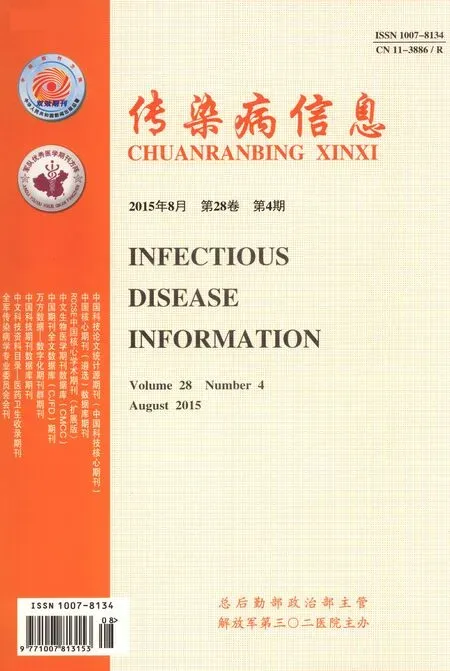肠道菌群与非酒精性脂肪性肝病研究进展
周达,范建高
·导向与述评·
肠道菌群与非酒精性脂肪性肝病研究进展
周达,范建高
非酒精性脂肪性肝病(nonalcoholic fatty liver disease,NAFLD)发病率不断升高,对其发生、发展及防治研究变得极为迫切。近年来肠道菌群被认为是机体一个重要的“特殊器官”,参与机体代谢及相关疾病的发生、发展,与NAFLD关系密切。本文就肠道菌群与NAFLD的关系研究进行综述。
脂肪肝;肠杆菌科;生态失调;内毒素类;乙醇
非酒精性脂肪性肝病(nonalcoholic fatty liver disease,NAFLD)发病率逐年增高,已成为我国第一大慢性肝病[1]。它是遗传-环境-代谢应激相关性疾病,以肝实质细胞脂肪变性和脂肪蓄积为特征,其疾病谱包括单纯性脂肪肝、非酒精性脂肪性肝炎(nonalcoholic steatohepatitis,NASH)、肝硬化甚至原发性肝癌[2]。NAFLD发病机制复杂[3],近年研究表明机体肠道菌群与NAFLD关系密切,为NAFLD发病机制及防治研究提供了新的切入点。
机体肠道内寄居着大量厌氧和兼性需氧细菌共生群体,可以看作是一个位于肠道内的特殊微生物器官,受宿主基因型及环境双重调控[4-5]。肠道菌群数量可达1014,其所含基因总量是人类的100倍之多,主要由厚壁菌门、拟杆菌门、放线菌门、疣微菌门、变形菌门等构成,以前二种为主(约占总体的90%)[6],影响着宿主发育、能量代谢和免疫功能,对机体各种生理病理活动发挥重要调节作用[7]。随着研究深入,肠道菌群与代谢性疾病之间的复杂机制越来越多得以阐述[8]。本文就肠道菌群与NAFLD之间的复杂调控关系进行阐述。
1 肠道菌群与肥胖和能量代谢
肥胖和胰岛素抵抗(insulin resistance,IR)是NAFLD发生发展的二大最重要因素[9]。大量人体和动物学研究均显示肥胖与肠道菌群密切相关[10]。肥胖者体内肠道菌群结构失调,厚壁菌门和放线菌门含量比例显著升高而拟杆菌门下降。通过移植肥胖者菌群至正常者,可引起后者明显肥胖,促进能量代谢吸收增加[11-12],而移植正常者菌群是否能够减轻肥胖、减少能量摄入仍不十分明确,但前景依然乐观。一项人体学研究提示,通过肠道菌群移植,增加了代谢综合征患者的胰岛素敏感性,同时改善其肠道菌群结构[13]。值得一提的是,肠道菌群与肥胖的复杂关系不能简单理解为厚壁菌门和拟杆菌门2种优势菌门比例失调造成,还包括内部微生物群结构的变化[14]。
Mouzaki等[15]研究显示,NASH患者肠道内拟杆菌含量比例比单纯性脂肪肝患者和健康对照者低,其粪便中球形梭菌含量比单纯性脂肪肝患者高,提示NASH的发病与粪便中拟杆菌的含量呈负相关,且不受饮食/体质量指数影响的。另一项研究也表明,肠道菌群可以不依赖于肥胖而独立促进NAFLD的发生,同时使机体对高脂饮食产生差异性反应[16]。
由此可知,肠道菌群与代谢性疾病关系密切,与NAFLD之间并非仅存在间接作用,而且存在相互的直接作用,后者更值得进一步探索,以发现其中的奥秘。
2 肠道菌群与内毒素
关于NAFLD的发病机制,较为认可的是“二次打击”学说。第一次打击主要是IR增加了肝细胞内脂质沉积;第二次打击主要是内质网应激、线粒体功能障碍、脂质过氧化及多种炎症因子的释放[3],上述机制均与肠道菌群密不可分。肠道菌群失调或过度生长可以引起肥胖及IR已无争议[17-18],此外还可以导致肠道内细菌毒素(如脂多糖)产生增多,破坏肠黏膜结构,使其通透性增加,促进毒素吸收和菌群移位,由门静脉入肝而进一步促进NAFLD发展[19]。同时,人体学及动物学均证实患NAFLD的机体存在小肠细菌过度生长及肠道通透性增加[20-21],二者互为促进,形成不良循环。
细菌毒素吸收增加,可通过门静脉直接造成肝细胞损害,同时脂多糖可以作用于肝内Kupffer细胞及星状细胞表面多种Toll样受体(Toll-like receptor, TLR),特别是TLR-4,激活受体下游MyD88和转录因子——核因子κB,最终促进其分泌各种促炎因子,如肿瘤坏死因子(tumor necrosis factor,TNF)-α以及白细胞介素(interleukin,IL)-1、IL-6、IL-18和IL-12等[3,22-23]。这些炎症因子又进一步促进IR、肝内脂质过氧化、内质网应激以及线粒体功能障碍,最终导致NAFLD的发展恶化[24-25]。但细菌毒素并非仅仅影响了促炎因子,而是造成促炎与抗炎因子失衡使疾病进展[22]。
此外,菌群异常可以抑制肠上皮细胞分泌饥饿诱导脂肪细胞因子,后者为脂肪酶抑制物,调节外周脂肪代谢,其被抑制后可以增加脂肪酶活性,促进脂肪细胞甘油三酯异位至肝脏,促进NAFLD的发展[19]。
3 肠道菌群与乙醇
近年来,众多研究发现:排除体外乙醇摄入情况,糖尿病和NASH患者体内乙醇含量均较健康对照者升高,意味着这部分患者自体产生过多乙醇,即内生性乙醇,同时NASH患者肝内代谢乙醇相关基因表达明显升高[26-28];肥胖患者或肥胖小鼠的血乙醇浓度较正常体重者增加[29-30];Zhu等[26]研究还发现,NASH患者的肠道菌群与肥胖者和健康者的肠道菌群存在明显的差异,NASH患者肠道内大肠埃希菌明显多于肥胖者。大肠埃希菌能够发酵产生乙醇,是内源性乙醇的主要来源[31]。内源性乙醇会被肝脏乙醇脱氢酶、过氧化氢酶及微粒体乙醇氧化系统代谢清除,但当乙醛脱氢酶活性过低时,造成乙醛代谢障碍,导致蓄积。乙醇和乙醛对组织和肝脏均可造成直接的氧化损伤,通过激活体内相关酶活性,导致体内氧自由基产生增多和脂质过氧化。同时,乙醛可以损害肠黏膜,导致肠黏膜通透性增加,内毒素吸收增多,促进NASH的发生及持续进展[32-33]。
在正常情况下,人体内会不断产生乙醇[34],肠道菌群发酵是内源性乙醇的主要来源,小肠细菌过度生长及肠道菌群紊乱均可导致内源性乙醇增多。由此可见,肠道菌群体内发酵不容忽视,其代谢发酵产物对人体病理生理至关重要[35],除了存在对机体不利的产物,也有相当多产物对机体有利,比如短链脂肪酸、维生素等[36]。因此如何高效、优化利用菌群代谢,使其对人体产生更加有益的作用有待进一步探讨。
4 肠道菌群与免疫
肠肝轴是肝肠对话的一个重要通路,除了传输各种营养、生理活性物质、众多病原性和免疫性物质,甚至推测淋巴细胞也通过肠肝轴循环由肠道转移至肝脏,参与NAFLD发生发展[37-39]。肠道菌群对机体免疫系统的发育成熟至关重要,同时机体免疫系统也影响宿主肠道菌群的最终结构[40-42]。
肠道黏膜及黏膜下层存在数量和种类众多的免疫细胞,与肠道菌群相互作用。肠道菌群可以调控肠道不同淋巴细胞亚群[如辅助性T细胞(T helper cells,Th)1/Th2、调节性T细胞/Th17]的分化,调节B细胞、自然杀伤T细胞、树突状细胞、巨噬细胞等免疫细胞功能活性,维持黏膜免疫系统中促炎与抗炎机制之间的动态平衡,是黏膜免疫稳态的关键调节因素,避免自身免疫[43-45];其失调可以导致免疫细胞比例失调,黏膜免疫稳态被打破,诱发炎性因子分泌紊乱,可通过肠肝轴直接影响到肝脏[42]。但是,肠道淋巴细胞特异性归巢入肝仍需要更多强有力的直接证据,而通过对肠道免疫干预是否可以防治NAFLD值得进一步探讨。
5 肠道菌群与NAFLD治疗
肠道菌群在NAFLD发生发展中的重要作用为NAFLD的干预和防治提供了崭新的思路,调节肠道菌群以改善NAFLD值得深层次研究[46]。
益生菌对各种病因所致慢性肝病均有改善作用。针对NAFLD的益生菌疗法不论在临床上还是动物实验中已得到支持[46-47],其可以提高宿主免疫力,抑制有害菌生长及移位,保护肠黏膜屏障,减少毒素吸收,显著降低肝内促炎因子(如干扰素γ、TNF-α、IL-1β、IL-6等)的表达分泌,改善IR,减轻NAFLD患者体内氧化/氮化应激,明显改善肝脏病理过程[46,48]。此外,可进行口服抗生素(如多粘菌素B)治疗,直接清除过度繁殖的致病菌,但该种方法容易破坏肠道正常定植菌,造成细菌耐药,存在一定的风险[46]。虽然有较多实验为益生菌治疗NAFLD提供了依据,但还须进行大样本临床随机对照试验。益生菌的真实疗效有待进一步明确。
我们在研究通过调节肠道菌群治疗NAFLD时,目光不仅要聚焦肠道菌群本身,更要关注其代谢产物(如短链脂肪酸等)的作用。目前同样有众多研究提示菌群代谢产物在改善和调节机体代谢方面发挥不可或缺的作用[49],也许二者联合可以提供更完整有效的NAFLD防治策略。
6 结语
NAFLD已成为全球性的第一大慢性肝病,并在未来长时间内将持续存在,但是至今没有明确的理想防治策略。深入研究肠道菌群在NAFLD发病和进展中所起的作用,使得发现该类疾病崭新的预防和治疗策略成为可能,也进一步使探索肠道菌群或其代谢相关产物作为对NAFLD系列疾病预测评估指标成为可能。
[1]Wang FS,Fan JG,Zhang Z,et al.The global burden of liver disease:themajor impact of China[J].Hepatology,2014,60(6):2099-2108.
[2]Duan XY,Zhang L,Fan JG,etal.NAFLD leads to liver cancer:do we have sufficient evidence?[J].Cancer Lett,2014,345(2):230-234.
[3]Yoon HJ,Cha BS.Pathogenesis and therapeutic approaches for non-alcoholic fatty liver disease[J].World JHepatol,2014,6(11): 800-811.
[4]Zoetendal EG,Akkermans AD,Akkermans-van Vliet WM,et al. The host genotype affects the bacterial community in the human gastronintestinal tract[J].Microb Ecol Health Dis,2001,13(3): 129-134.
[5]Derrien M,van Hylckama Vlieg JE.Fate,activity,and impact of ingested bacteriawithin the human gutmicrobiota[J].TrendsMicrobiol,2015,23(6):354-366.
[6]Lozupone CA,Stombaugh JI,Gordon JI,et al.Diversity,stability and resilience of the human gutmicrobiota[J].Nature,2012,489 (7415):220-230.
[7]Tremaroli V,Bäckhed F.Functional interactions between the gut microbiota and hostmetabolism[J].Nature,2012,489(7415):242-249.
[8]Hartstra AV,Bouter KEC,Bäckhed F,et al.Insights into the role of the microbiome in obesity and type 2 diabetes[J].Diabetes Care,2015,38(1):159-165.
[9]Gangarapu V,Yildiz K,Ince AT,et al.Role of gut microbiota: obesity and NAFLD[J].Turk JGastroenterol,2014,25(2):133-140.
[10]Biedermann L,Rogler G.The intestinal microbiota:its role in health and disease[J].Eur JPediatr,2015,174(2):151-167.
[11]Ridaura VK,Faith JJ,Rey FE,et al.Gut microbiota from twins discordant for obesity modulate metabolism in mice[J].Science, 2013,341(6150):1241214.
[12]Turnbaugh PJ,Ley RE,Mahowald MA,etal.An obesity-associated gutmicrobiome with increased capacity for energy harvest[J]. Nature,2006,444(7122):1027-1031.
[13]Vrieze A,Van Nood E,Holleman F,et al.Transfer of intestinal microbiota from lean donors increases insulin sensitivity in individuals with metabolic syndrome[J].Gastroenterology,2012,143 (4):913-916.e7.
[14]Santacruz A,Marcos A,Wärnberg J,etal.Interplay between weight loss and gutmicrobiota composition in overweight adolescents[J].Obesity(Silver Spring),2009,17(10):1906-1915.
[15]MouzakiM,Comelli EM,Arendt BM,etal.Intestinalmicrobiota in patientswith nonalcoholic fatty liver disease[J].Hepatology,2013, 58(1):120-127.
[16]Le Roy T,Llopis M,Lepage P,et al.Intestinalmicrobiota determines development of non-alcoholic fatty liver disease in mice[J]. Gut,2013,62(12):1787-1794.
[17]Dumas ME,Barton RH,Toye A,etal.Metabolic profiling reveals a contribution of gut microbiota to fatty liver phenotype in insulin-resistantmice[J].Proc Natl Acad Sci U SA,2006,103(33): 12511-12516.
[18]Nieuwdorp M,Gilijamse PW,Pai N,etal.Role of themicrobiome in energy regulation and metabolism[J].Gastroenterology,2014, 146(6):1525-1533.
[19]Ferolla SM,Armiliato GN,Couto CA,etal.The Role of intestinal bacteria overgrowth in obesity-related nonalcoholic fatty liver disease[J].Nutrients,2014,6(12):5583-5599.
[20]Miele L,Valenza V,La Torre G,etal.Increased intestinal permeability and tight junction alterations in nonalcoholic fatty liver disease[J].Hepatology,2009,49(6):1877-1887.
[21]Brun P,Castagliuolo I,Di Leo V,etal.Increased intestinal permeability in obese mice:new evidence in the pathogenesis of nonalcoholic steatohepatitis[J].Am JPhysiol Gastrointest Liver Physiol, 2007,292(2):G518-G525.
[22]Su GL.Lipopolysaccharides in liver injury:molecularmechanisms of Kupffer cell activation[J].Am JPhysiol Gastrointest Liver Physiol,2002,283(2):G256-G265.
[23]Li L,Chen L,Hu L,etal.Nuclear factor high-mobility group box1 mediating the activation of Toll-like receptor 4 signaling in hepatocytes in the early stage of nonalcoholic fatty liver disease in mice[J].Hepatology,2011,54(5):1620-1630.
[24]Haghani K,Pashaei S,Vakili S,etal.TNF-alpha knockdown alleviates palmitate-induced insulin resistance in C2C12 skeletal muscle cells[J].Biochem Biophys Res Commun,2015,460(4):977-982.
[25]Passos E,Ascensão A,Martins MJ,et al.Endoplasmic reticulum stress response in non-alcoholic steatohepatitis:the possible role of physical exercise[J].Metabolism,2015,64(7):780-792.
[26]Zhu L,Baker SS,Gill C,etal.Characterization of gutmicrobiomes in nonalcoholic steatohepatitis(NASH)patients:a connection between endogenous alcohol and NASH[J].Hepatology,2013,57(2): 601-609.
[27]Simic M,Ajdukovic N,Veselinovic I,et al.Endogenous ethanol production in patients with diabetes mellitus as a medicolegal problem[J].Forensic Sci Int,2012,216(1-3):97-100.
[28]Baker SS,Baker RD,Liu W,etal.Role of alcoholmetabolism in non-alcoholic steatohepatitis[J].PLoSONE,2010,5(3):e9570.
[29]Nair S,Cope K,Risby TH,et al.Obesity and female gender increase breath ethanol concentration:potential implications for the pathogenesis of nonalcoholic steatohepatitis[J].Am JGastroenterol,2001,96(4):1200-1204.
[30]Cope K,Risby T,Diehl AM.Increased gastrointestinal ethanol production in obese mice:implications for fatty liver disease pathogenesis[J].Gastroenterology,2000,119(5):1340-1347.
[31]Hiroe A,Hyakutake M,Thomson NM,et al.Endogenous ethanol affects biopolyester molecular weight in recombinant Escherichia coli[J].ACSChem Biol,2013,8(11):2568-2576.
[32]Farfán Labonne BE,Gutiérrez M,Gómez-Quiroz LE,et al.Acetaldehyde-induced mitochondrial dysfunction sensitizes hepatocytes to oxidative damage[J].Cell Biol Toxicol,2009,25(6):599-609.
[33]Rao RK.Acetaldehyde-induced barrier disruption and paracellular permeability in Caco-2 cell monolayer[J].Methods Mol Biol, 2008,447:171-183.
[34]Sarkola T,Eriksson CJ.Effect of 4-methylpyrazole on endogenous plasma ethanol and methanol levels in humans[J].Alcohol Clin Exp Res,2001,25(4):513-516.
[35]Cordell B,McCarthy J.A Case study of gut fermentation syndrome (auto-brewery)with Saccharomyces cerevisiae as the causative organism[J].Int JClin Med,2013,4:309-312.
[36]Kim CH,Park J,Kim M.Gutmicrobiota-derived short-chain fatty acids,T cells,and inflammation[J].Immune Netw,2014,14(6): 277-288.
[37]Balmer ML,Slack E,de Gottardi A,etal.The livermay act as a firewallmediating mutualism between the host and its gut commensalmicrobiota[J].Sci TranslMed,2014,6(237):237ra66.
[38]Neumann K,Kruse N,Szilagyi B,et al.Connecting liver and gut: murine liver sinusoidal endothelium induces gut tropism of CD4+T cells via retinoic acid[J].Hepatology,2012,55(6):1976-1984.
[39]Pabst O.Trafficking of regulatory T cells in the intestinal immune system[J].Int Immunol,2013,25(3):139-143.
[40]Maynard CL,Elson CO,Hatton RD,et al.Reciprocal interactions of the intestinalmicrobiota and immune system[J].Nature,2012, 489(7415):231-241.
[41]Olszak T,An D,Zeissig S,et al.Microbial exposure during early life has persistent effects on natural killer T cell function[J].Science,2012,336(6080):489-493.
[42]Chung H,Pamp SJ,Hill JA,etal.Gut immunematuration depends on colonization with a host-specific microbiota[J].Cell,2012,149 (7):1578-1593.
[43]Hooper LV,Littman DR,Macpherson AJ.Interactions between the microbiota and the immune system[J].Science,2012,336(6086): 1268-1273.
[44]Wu HJ,Wu E.The role of gutmicrobiota in immune homeostasis and autoimmunity[J].Gut Microbes,2012,3(1):4-14.
[45]Shulzhenko N,Morgun A,Hsiao W,et al.Crosstalk between B lymphocytes,microbiota and the intestinal epithelium governs immunity versus metabolism in the gut[J].Nat Med,2011,17(12): 1585-1593.
[46]Compare D,Coccoli P,Rocco A,etal.Gut--liver axis:the impact of gut microbiota on non alcoholic fatty liver disease[J].Nutr, Metab Cardiovasc Dis,2012,22(6):471-476.
[47]Loguercio C,Federico A,Tuccillo C,et al.Beneficial effects of a probiotic VSL#3 on parameters of liver dysfunction in chronic liver diseases[J].JClin Gastroenterol,2005,39(6):540-543.
[48]Cesaro C,Tiso A,Del Prete A,etal.Gutmicrobiota and probiotics in chronic liver diseases[J].Dig Liver Dis,2011,43(6):431-438.
[49]Chambers ES,Morrison DJ,Frost G.Control of appetite and energy intake by SCFA:what are the potential underlyingmechanisms?[J].Proc Nutr Soc,2014,12:1-9.
(2015-04-21收稿2015-06-05修回)
(责任编委李军本文编辑王姝)
Research progress of the correlation between intestinalm icrobiota and nonalcoholic fatty liver disease
ZHOU Da,FAN Jian-gao*
Department of Gastroenterology,Xinhua Hospital,Shanghai Jiaotong University School of Medicine,Shanghai200092,China
*Corresponding author,E-mail:fattyliver2004@126.com
Currently,themorbidity ofnonalcoholic fatty liver disease(NAFLD)is increasing,so it is extremely pivotal to study the development,progression,prevention and treatmentof NAFLD.Intestinalmicrobiota,as an importantand special organ of the body, intimately participates in the metabolism of the body,and the development and progression of NAFLD as well.In this article,the correlation between intestinalmicrobiota and NAFLD is reviewed.
fatty liver;Enterobacteriaceae;dysbiosis;endotoxins;ethanol
R575.5;R378.1
A
1007-8134(2015)04-0200-04
10.3969/j.issn.1007-8134.2015.04.003
国家重点基础研究发展计划(973计划)项目(2012CB 517501);国家自然基金(81070322、81270491、81470840);上海市科委课题(0914090350、10411956300);中国肝炎防治基金(XJS20120 501);上海市卫生局百人计划(XBR 2011007)
200092,上海交通大学医学院附属新华医院消化内科(周达、范建高)
范建高,E-mail:fattyliver2004@126.com

